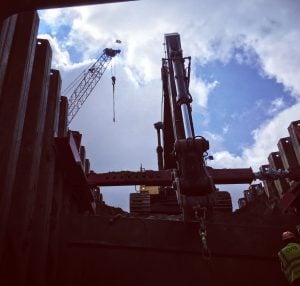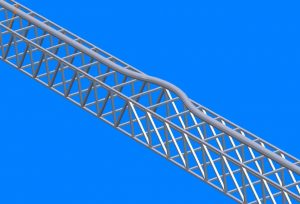It’s that time of year when cold weather scaffold users start wrapping scaffolds in enclosures for weather protection and warmth. Since wrapping a scaffold in an enclosure seriously changes the forces that are applied to scaffolds, the installation of such systems must be carefully designed and executed.
Conditions vary greatly across North America and it is impossible to provide specific instructions for enclosing a scaffold. Why is this? Many factors affect the forces that occur when a scaffold is wrapped. These factors include:
• Height of the scaffold
• Length of the scaffold
• Width of the scaffold
• Shape of the adjacent structure
• Location of the structure and scaffold
• Proximity of other adjacent structures
• Terrain
• Local weather conditions
• Material used for the enclosure
• Scaffold loads
• Tie location
In spite of the variables, some general observations can be made. First and foremost, typical tie design and spacing probably will not work. While the Occupational Safety and Health Administration, (OSHA), specifies maximum permissible vertical and horizontal tie spacing in its’ standards, it must be remembered that these are minimum standards and only provide stability to the scaffold; this minimum tie spacing does not provide strength against wind forces. Typically, the ties used on an enclosed scaffold should be designed by a qualified person who is familiar with the forces that occur. Many times, erectors casually assume that “doubling up” the ties is sufficient. This assumption can lead to disastrous results.
Second, the choice of fabric used for enclosures will affect the scaffold and ties in a variety of ways. For example, vibration is very significant due to the buffeting of the wind and can loosen expansion anchors that are used to hold the ties. The choice of enclosure material also affects the scaffold. A stiff enclosure fabric, securely fastened to the scaffold, will produce less vibration than a flexible material such as plastic sheeting.
Third, the method used to tie the enclosure to the scaffold will affect both the tie design and the forces on the scaffold. Generally, there are two approaches that can be used to design a wrapped scaffold. The first method, generally uneconomical and counterproductive, assumes that the enclosure will release from the scaffold at a certain wind speed, minimizing the chances that the scaffold will pull away from the structure and fall over. In this design, the connection between the enclosure and the scaffold is such that it will either break or release the enclosure once the wind exceeds a certain velocity. The assumption is that a design such as this will minimize the number of ties required to restrain the scaffold. This can be a very dangerous approach, especially if an uninformed user modifies the enclosure connection. How far the enclosure flies and where it lands upon completion of the flight should be of concern to the scaffold erector! The second design method assumes that the enclosure is adequately secured to the scaffold. The restraint system is designed to support the scaffold and enclosure as one unit. A much preferred method of design, the scaffold and enclosure will continue to provide protection and access throughout the project.
What are the forces? Can a standard wire tie handle the load? As stated earlier, it is impossible to accurately state the loads on a wrapped scaffold without a specific analysis of the scaffold. However, various wind forces can be described so that you have an idea of the forces that can be generated. If the wind speed at the project is 20 mph, the basic force in the middle of the scaffold is approximately 1 pound per square foot. If the wind picks up to a 40 mph breeze, the load increases to 4 pounds per square foot. At a 60 mph breeze, the force increases to 9 pounds per square foot. Using the OSHA standards as a reference, the force on the tie, at 20 miles per hour, would be 800 pounds. Applying the 4 to 1 safety factor, the tie would be designed for 3,200 pounds. At 60 miles per hour, the force on the tie would be minimum 7,020 pounds. Applying the standard safety factor, the tie must be designed for at least 28,000 pounds. You would need quite a bit of wire to handle that kind of force. Keep in mind that these forces have not taken into consideration the factors that will increase the load substantially, in some cases doubling the load. These increases in forces occur at corners, roofs, and other areas where the wind is affected by other structures or the surrounding terrain.
Wrapping scaffolds should not be taken lightly. Qualified scaffold designers should be consulted before erecting the scaffold. Your safety, and the safety of your fellow workers, demands a proper design.













